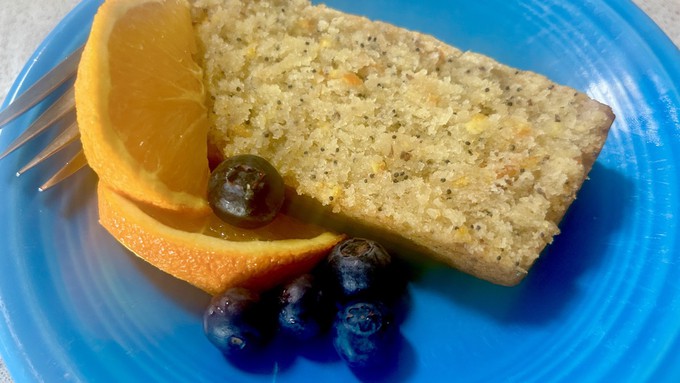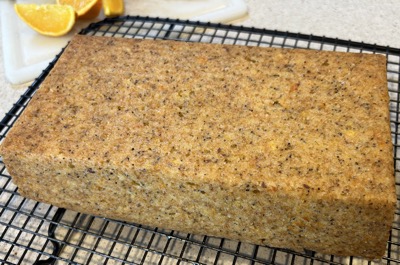
Recipe: Poppy seeds add texture to vegan snack cake

Poppy seeds and orange zest add visual interest to this moist orange loaf cake. Kathy Morrison
As citrus season rolls on through the end of winter, I felt the urge to bake something with oranges. Poking around online, I found a reference to "orange poppy lazy loaf" that led to Gretchen's Vegan Bakery.
I'm not a vegan cook, but I like to try plant-based recipes. Gretchen has a very active blog, and a wealth of recipes available, if vegan baking is your preference.

The orange loaf recipe is called "lazy," apparently, because the whole orange is used, skin and all, puréed in a food processor with all the other ingredients. (OK, not the stem or potential seeds, but everything else.)
I've make other whole-orange recipes before: The Almond & Orange Cake in our Taste Winter! cookbook is gluten- and dairy-free, though it uses 6 eggs, so definitely not vegan.
This recipe, unlike the other, doesn't require boiling the oranges first, but Gretchen warns to use oranges with thin skins (meaning less bitter pith), totaling about 5 ounces. I had one Cara Cara orange left that, minus the stem, weighed in at 5.1 ounces. Perfect. Mandarins or clementines also would be good choices.
I diverged from the original recipe in mixing and somewhat in ingredients. The primary difference is that she used Bob's Red Mill egg replacer, while I used a "flaxseed egg." The recipe here is my adaptation, which is less "lazy" but makes more sense to me.
Orange poppy seed snack loaf
Makes one 5-by-10-inch loaf
Ingredients:
3/4 cup non-dairy milk (I used oat milk)
1 tablespoon ground flaxseed
1 small navel orange or 2 small clementines, total weight about 5 ounces, stem end removed
1 scant cup granulated sugar (195 grams)
1/2 cup vegetable oil
2 teaspoons vanilla extract
1-3/4 cup unbleached all-purpose flour
3 teaspoons baking powder
3/4 teaspoon salt
2 teaspoons (or more) poppy seeds
Optional light* glaze:
1/2 tablespoon fresh orange juice
3 to 4 tablespoons powdered sugar
Instructions:
Grease a 5-by-10-inch loaf pan. Preheat oven to 350 degrees.
Measure the non-dairy milk into a 1 cup glass measuring cup. Stir in the ground flaxseed, and set aside.
Cut the orange in half or quarters to check for seeds. Remove any seeds and any thick interior stem. Place the orange pieces, with skin intact, in a food processor or blender. Add the granulated sugar and blend at high speed until the orange and sugar are puréed and well combined. (There will be small pieces of skin visible, which is OK.)
Scrape the orange mixture into a large bowl. Whisk in the oil, then the vanilla and the flaxseed-milk mixture.
In a medium bowl, whisk together the flour, baking powder, salt and poppy seeds. Blend the dry ingredients into the wet ingredients with a wooden spoon or rubber spatula, being careful not to over-mix.
Pour the batter into the prepared loaf pan. Bake for 40-45 minutes, or until a toothpick stuck in the middle of the loaf comes out clean.

Place the pan on a cooling rack, and let the loaf cool for about 10 minutes. Then remove it from the pan to the rack and allow to cool completely before glazing or serving.
*Note: I made a small amount of light glaze for the top of the loaf, but this is optional. If a thicker glaze is desired for a dessert presentation, combine 1 cup confectioner's sugar with 1 tablespoon fresh juice and 1-1/2 teaspoon orange zest. Garnish with orange slices and/or more poppy seeds, as desired.
Comments
0 comments have been posted.Sacramento Digs Gardening to your inbox.
Sites We Like
Garden Checklist for week of July 21
Your garden needs you!
* Keep your vegetable garden watered, mulched and weeded. Water before 8 a.m. to reduce the chance of fungal infection and to conserve moisture.
* Feed vegetable plants bone meal, rock phosphate or other fertilizers high in phosphate to stimulate more blooms and fruiting. (But wait until daily high temperatures drop out of the 100s.)
* Don’t let tomatoes wilt or dry out completely. Give tomatoes a deep watering two to three times a week.
* Harvest vegetables promptly to encourage plants to produce more. Squash especially tends to grow rapidly in hot weather. Keep an eye on zucchini.
* Pinch back chrysanthemums for bushy plants and more flowers in September.
* Remove spent flowers from roses, daylilies and other bloomers as they finish flowering.
* Pinch off blooms from basil so the plant will grow more leaves.
* Cut back lavender after flowering to promote a second bloom.
* It's not too late to add a splash of color. Plant petunias, snapdragons, zinnias and marigolds.
* From seed, plant corn, pumpkins, radishes, winter squash and sunflowers.